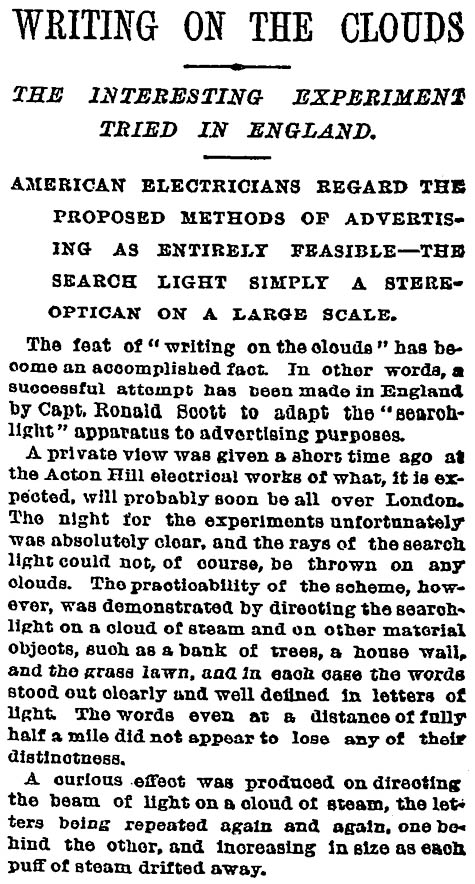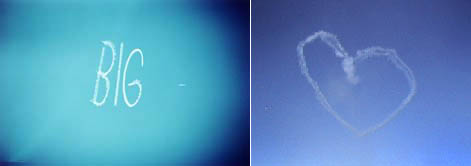Sky.doc
 [Image: A flying logo, or Flogo].
[Image: A flying logo, or Flogo].Over on LiveScience we learn that a new company has started using "a mixture of soap-based foams and lighter-than-air gases such as helium" to create "floating ads and messages" in the sky.
Unfortunately dubbed Flogos, these floating logos can be made – or printed, really – every 15 seconds by "re-purposed snow machines," thus "flooding the air with foamy peace signs or whatever shape a client desires. Renting the machine for a day starts out at a cost of about $2,500."
I should start blogging with it.
The sky texts aren't particularly large, however. They're only "about two feet long and nearly a foot wide" – but they "generally last anywhere from a few minutes to an hour, depending on conditions in the atmosphere."
"They will fly for miles," their inventor adds – because they are "durable," capable of flying as high as 20,000 feet without breaking up. Gaseous typography.
It won't just be meteorologists watching the skies, in other words, but graphic designers. Adjusting leading, kerning the clouds, ragging atmospheres.
And what about abstract typography – printing random cloud-shapes on a massive scale? Future paranoias appear in the diagnostic handbooks of tomorrow's most expensive psychiatrists. Patients stumble in, demanding to know if those clouds are really signs... And, if so, who put them there, what they say – and what about that one...
Flying through these atmospheric print-outs, meanwhile, is "like going through a cloud" – and thus, apparently, safe. Just a minor bit of literary turbulence as you pass through a challenging paragraph.
But this ability to print aerial images also hints at what could be called the immersive sky-cinema of tomorrow: you get into the cockpit of a small airplane and you fly through artificial clouds – clouds that have been printed to look like a sequence of animated cells. You proceed to fly through this cloud-by-cloud narrative, perhaps even reading word bubbles and thought balloons – subtitles – or you play a carefully synched soundtrack on your iPod. Soon, you can leave commentary in the air with your own re-purposed snow machine. Metacommentary. Footnotes.
Or perhaps music written in the sky + a local radio station playing that song = SkyKaraoke™.
In any case, I originally saw this bit of news on MetaFilter – where we also find a link to an article published in the New York Times back in 1892. Here it is as a PDF and as a JPG.
 [Image: From an article published in 1892 in the New York Times. Read as PDF or JPG].
[Image: From an article published in 1892 in the New York Times. Read as PDF or JPG].Apparently documenting the very birth of skywriting – that "interesting experiment" of typesetting the sky – the article relates what it describes as the "curious effect" of seeing letters and signs mid-air. Clouds of steam become a new textual presence in space.
In any case, there is an obvious (and, frankly, rather uninteresting) reaction to all this – i.e. please save us from yet another form of corporate advertising, we don't need logos in the sky – but there are also artistic, and even literary, implications here that go beyond mere outrage.
 1) If you put this into the context of weather control as an emerging technique for urban design – for instance, what we're seeing in Beijing with the Olympics – then these sorts of cloud-printing techniques open up a whole new front in any serious discussion of public space and the city. The question here might be: what are the political and/or municipal implications of being able to typographically format the skies? I'm reminded of Roberto Bolaño's novel Distant Star, in which a Nazi-sympathizing South American poet turns to skywriting, putting his poems in the clouds after a right-wing coup d'état, scrawling three-dimensional diatribes in the subtropical air.
1) If you put this into the context of weather control as an emerging technique for urban design – for instance, what we're seeing in Beijing with the Olympics – then these sorts of cloud-printing techniques open up a whole new front in any serious discussion of public space and the city. The question here might be: what are the political and/or municipal implications of being able to typographically format the skies? I'm reminded of Roberto Bolaño's novel Distant Star, in which a Nazi-sympathizing South American poet turns to skywriting, putting his poems in the clouds after a right-wing coup d'état, scrawling three-dimensional diatribes in the subtropical air. 2) If graphic design suddenly becomes atmospherically relevant, so to speak, will we someday read an issue of PRINT or an essay on Design Observer about well-rounded cloud forms – how, perhaps, the skies above Amsterdam are beautifully sans serif, whilst the skies of Rome are well-paragraphed but poorly spaced...? Then you play an April Fool's joke: you send a design critic to some city where they don't print the clouds at all – but you ask him or her to critique their newest font... Six pages of embarrassing sky criticism ensue.
3) If typography also bears information, of course, then perhaps tomorrow's literature will be skybound, no longer bound in books. Penguin's UK-based We Tell Stories initiative abandons the internet entirely to print stories in the skies above Bloomsbury or Liverpool or even Hay-on-Wye. Much was made years and years ago about William Gibson's self-erasing book Agrippa (A Book of the Dead), but why not repeat that performance with a book printed only once, in the air, off a dock on the east coast of England? It disperses across the Channel in a haze of typography – a particularly robust paragraph or two flying as far as Paris, where still intelligible letters float past the bedroom window of a 13 year-old hopeful game designer... who gets an idea.
 4) Perhaps we all really should give up internet-based blogging and switch instead to the sky. I could buy a small shack on a hill somewhere in Los Angeles and grow a beard. Turning my back on representational form, I'll emit abstractions of well-made foam into the sky on windy days. Air sculptures, like something by Marcel Duchamp, floating over parking lots and across the yards of the rich and famous. Harrison Ford is interviewed by Variety: "I saw very strange clouds last night," he says, still visibly stunned, his voice shaken. "They were made of foam – and they... they were really quite beautiful."
4) Perhaps we all really should give up internet-based blogging and switch instead to the sky. I could buy a small shack on a hill somewhere in Los Angeles and grow a beard. Turning my back on representational form, I'll emit abstractions of well-made foam into the sky on windy days. Air sculptures, like something by Marcel Duchamp, floating over parking lots and across the yards of the rich and famous. Harrison Ford is interviewed by Variety: "I saw very strange clouds last night," he says, still visibly stunned, his voice shaken. "They were made of foam – and they... they were really quite beautiful."5) For the rest of human history, no one trusts the clouds. No one knows for sure if they are natural. Everything appears to be printed. Like those infamous numbers stations – radio broadcasts of uncertain origin which appear to be involved with international espionage – strange cloud forms seen over factories in Berlin are studied for their possible meanings. Cloud cryptography. An aerial Enigma machine. New political departments – combining handwriting analysis, graphic design, linguistics, meteorology, advanced statistics, and spycraft – are formed by governments all over the world. 24-hour surveillance of the skies ensues.
(Via MetaFilter).





Comments are moderated.
If it's not spam, it will appear here shortly!
I want someone to hook up a Flogos machine to my twitter account. SkyTweets!
Nice
Tomorrow I'm only using smoke signals.
maybe vik muniz's cloud pictures are part of this as well...
Hi,
It's the first time that I read about this.
It's interesting and the price seems ok (I could not afford it though :-) ).
But can it respect aerial restrictions, such as airport space?
What about if it's near a frontier and passes over to another country ?
What about if I go grab a snack ?
I'm hungry :-)
Kind regards,
José
I read your article with a lot of interest. Unfortunately , I am bound to take the rather obvious "uninteresting" reaction to this. I think its rather scary that we could reach a point where we can't tell the difference between real clouds or made-up ones, between new visions of cloud imagery or natural formations. In any case, I should add to one of your scenarios the following: imagine this tool becomes another tool for selective control beyond boundaries, and that this technique would only be available to the fortunate few countries. It can easily become a form of cultural and mental manipulation from one side of a political boundary to another. You can't stop clouds from drifting, and if clouds become imprints of delibrate hostility, then we're looking at another form of social/political control. I do come from a land where the sky is not really ours, it is constantly military controlled and used as a surveillance tool by our neighbouring country, but at least they haven't been able to manipulate our thinking... yet. Thanks for the article and sorry for my somber note :)
Have you read Ballard's Vermilion Sands? There's a story about cloud sculpting in there somewhere, really good stuff.
Think of the pornographic possibilities...
Post a Comment